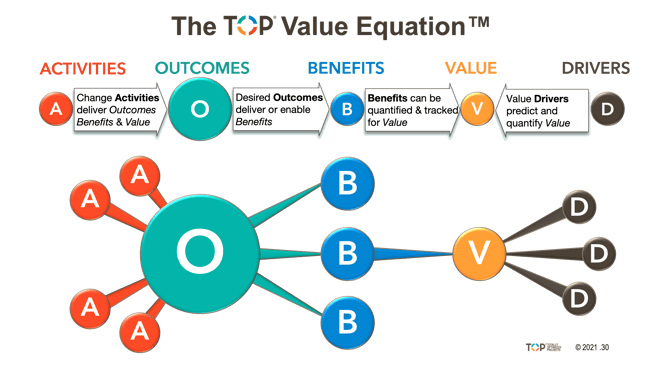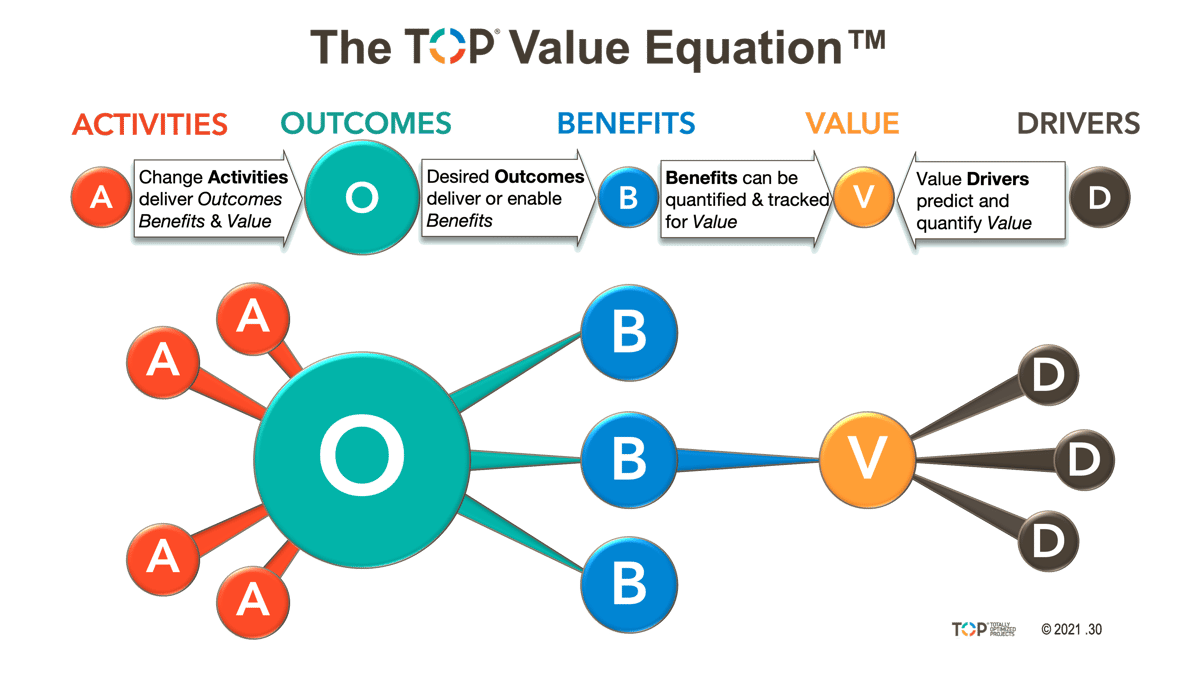Benefits management is still a 'hoped for' result on most projects.
Recent research found less than 30% of companies actually try to measure their projects' benefits - yet getting the benefits is why projects are commissioned in the first place.
One major reason for this sad state of affairs is the lack of a clear visible link between what the project delivers and the desired project benefits and value. This gap is bridged by "The Value Equation"™ a simple model that allows each element of the value delivery process - from project activities to value realization and measurement - measurable and manageable.
The Value Equation™ makes benefits and value management effective and easy.
The Value Equation changes how you do projects
The objective of a project is to deliver value to the organization. This simple basic concept is too often lost in the hustle and bustle of project delivery. The focus on value is too often lost because it is not clear how value is generated, delivered or realized.
The Value Equation™ makes clear how value is generated, and in doing so introduces some key concepts critical to project success and value management.

Desired business outcomes (O)
The most critical concept is that of 'desired business outcomes'. These are the business end states that are required to enable and deliver the benefits and value. This is where the business wants and needs to get to for the project to be a success.
Few projects currently define their 'desired business outcomes'. What they usually have are unmeasurable objectives, project outputs and deliverables and a lot of assumptions buried in their documentation.
One key dimension of 'desired business outcomes' is that they are measurable by a true/false question - Do we or don't we? Can we or can't we? Have we or haven't we?
Another key dimension is that they define the true end states to be realized. Too often projects head off towards some interim goal that won't actually enable the delivery of the benefits. Implementation of a system is a common example. No organization exits to run a system; the implementation of a system is a step along the way towards the true end state, which might be, for example, "We have a clear 12-month forward projection of our key customers' planned ordering requirements". This 12-month plan end state is quite different to, say, the existence of an installed CRM system.
So the first critical consequence of the Value Equation™ is the need for your project to define its true 'desired business outcomes'.
Project activities (A)
The project's progress towards and contribution to these desired business outcomes can then be tracked. Every project activity should be able to be aligned to the outcome(s) it is delivering.
Again, these project activities should be measurable so that their completion can be tracked and measured (and quality controlled). You can then measure progress towards the delivery of each and every Outcome. This give a much clearer focus for project activities from a business point of view.
Benefits (B)
Benefits are different to the desired business outcomes/end states and the quantified value. The benefits spell out in measurable terms the non-quantified nature of the value.
Benefits are delivered or enabled by Outcomes. No Outcomes, no benefits.
But, importantly, realization of the benefits can be measured separately from the realization of the value. So, if your benefit is, say, 'Products are delivered to market in half the current time' this can be measured as achieved or not (are they or aren't they?). The dollar value of this benefit is a separate measure. This is important if the dollar value changes substantially - Did we achieve the benefit? is one question. Did we realize the value? is another. They need to be defined and measured separately.
Value (V) and Value drivers (D)
The dollar (or other measure) value of a benefit is the most unstable element of the value equation as external events can impact and change the value drivers and, therefore, change the benefit's value.
For example, a value computed with an exchange rate of 1-2 dollars will be different if the dollar is devalued and results in an exchange rate of 1-2.2. No one in the business can control the exchange rate but it would, in this case, impact the realisable value of the benefit.
However, both the value and changes to the value drivers are still able to be measured. Variances due to external events can be tracked and explained. So, while, in our example, the exchange rate may have changed the value of the benefit, this value change can be tracked and explained. This ensures your project's value is managed from all dimensions.
Understanding The Value Equation™ allows the Governance Team to track and measure the delivery of the project's value from the project's activities through the delivery of the Outcomes and on to any external impacts.
Management to The Value Equation overrides management to the project plans for the Governance Team.



